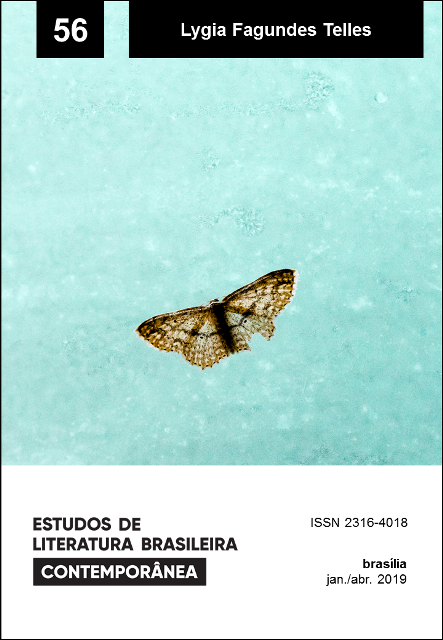Desire of beauty and ritual in Amerindian verbal arts
DOI:
https://doi.org/10.1590/2316-40185615Keywords:
Mbyá-Guarani, verbal arts, ritual, authorshipAbstract
This essay aims at discussing an aesthetic practice involving storytelling. Quem Conta um Conto is a group connected with the Universidade Federal do Rio Grande do Sul that has been experimenting with activities related to oral narratives in a Mbyá-Guarani school. Considering the desire for beauty that underpins indigenous life, it has been possible, by means of verbal art, to understand the relationships between different kinds of poetics. Verbal art has also been a helpful tool in understanding the ways in which this community creatively borrows from other people’s points of view. It has also been possible to understand Amerindian artistic practices as ritualistic means of maintaining both the balance of the cosmos and of the community.
References
BENJAMIN, Walter (1987). Rua de mão única. Tradução de Rubens Rodrigues Torres Filho. São Paulo: Brasiliense. (Obras Escolhidas, v. 2)
BRASIL (1988). Constituição da República Federativa do Brasil. Brasília, DF: Senado Federal. Disponível em: http://www.planalto.gov.br/ccivil_03/constituicao/constituicao.htm. Acesso em: 20 abr. 2016.
CUNHA, Manuela Carneiro da (2009). “Cultura” e cultura: conhecimentos tradicionais e direitos intelectuais. In: CUNHA, Manuela Carneiro da. Cultura com aspas. São Paulo: Cosac Naify. p. 311-373.
CESARINO, Pedro de Niemeyer (2006). De duplos e estereoscópios: paralelismo e personificação nos cantos xamanísticos ameríndios. Mana, Rio de Janeiro, v. 12, n. 1, p. 105-134.
FIOROTTI, Devair; OLIVEIRA, Jociane Gomes de (2016). Erencon, a literatura e os haicais. Revista Boitatá, Londrina, n. 22, p. 49-67, jul./dez.
GALLOIS, Dominique Tilkin (2016). A escola como problema: algumas posições. In: CUNHA, Manuela Carneiro da; CESARINO, Pedro de Niemeyer (Org.). Políticas culturais e povos indígenas. São Paulo: Editora da Unesp. p. 509-517.
JEKUPÉ, Olívio (2013) (Org.). As queixadas e outros contos guaranis. Ilustrado por Fernando Vilela. São Paulo: FTD.
KUSCH, Rodolfo (2009). El pensamento indígena y popular en América. In: KUSCH, Rodolfo. Obras completas. Rosário: Fundación A Ross. p. 255-546.
LADEIRA, Maria Inês (2007). O caminhar sob a luz. São Paulo: Editora Unesp.
LAGROU, Els (2009). Arte indígena no Brasil: agência, alteridade e relação. Belo Horizonte: C/Arte.
LIMA, Joaquim Maná de et al. (2016). Observações sobre o processo de patrimonialização dos Kene Huni Kuá¿–. In: CUNHA, Manuela Carneiro da; CESARINO, Pedro de Niemeyer (Orgs.). Políticas culturais e povos indígenas. São Paulo: Editora da Unesp. p. 219-240.
MATO, Daniel (2005). Interculturalidad, producción de conocimientos y prácticas socioeducativas. Alceu, Rio de Janeiro, v. 6, n. 11, p. 120-138, jul./dez.
MENEZES, Magali Mendes et al (2015). Um olhar sobre o olhar indígena e suas escol(h)as. Education policy analysis archives, San Andrés, v. 23, n. 97, p. 1-29, out. Disponível em: http://epaa.asu.edu/ojs/article/view/2044/1678. Acesso em: 12 ago. 2016.
OLIVEIRA, Joana Cabral de; SANTOS, Lucas Keese dos (2016). “Perguntas demais” ”“ multiplicidades de modos de conhecer em uma experiência de formação de pesquisadores Guarani Mbya. In: CUNHA, Manuela Carneiro da; CESARINO, Pedro de Niemeyer (Org.). Políticas culturais e povos indígenas. São Paulo: Editora da Unesp. p. 113-133.
PISSOLATO, Elizabeth (2008). Dimensões do bonito. Espaço Ameríndio, Porto Alegre, v. 2, n. 2, p. 35-51, jul./dez.
RIBEIRO, Berta (1986a). Introdução. In: RIBEIRO, Berta (Coord.). Suma etnológica brasileira. Petrópolis: Vozes, v. 2, p. 18-27. Disponível em: http://www.etnolinguistica.org/suma. Acesso em: 11 jul. 2016.
RIBEIRO, Darcy (1986b). Arte índia. In: RIBEIRO, Darcy (Ed.) et al. Suma etnológica brasileira. Petrópolis: Vozes, v. 3, p. 27-54. Disponível em: http://www.etnolinguistica.org/suma. Acesso em: 11 jul. 2016.
RISÉRIO, Antônio (1993). Textos e tribos: poéticas extraocidentais nos trópicos brasileiros. Rio de Janeiro: Imago.
TETTAMANZY, Ana Lúcia Liberato; RIVOIRE, Luciene (2013). Histórias para povoar as matas: os Mbyá-Guarani entre voz e letra. In: FARENZENA, Nalu (Org.). ENCONTRO INTERNACIONAL DE INVESTIGADORES DE POLÍTICAS LINGUÍSTICAS, 6., 23-25 nov 2013. Porto Alegre: UFRGS. p. 218-225.
VIDAL, Lux; SILVA, Aracy Lopes da (1995). O sistema de objetos nas sociedades indígenas: arte e cultura material. In: SILVA, Aracy Lopes da; GRUPIONI, Luís Donisete Benzi (Orgs.). A temática indígena na escola. Brasília: MEC, p. 369-406.
VIEIRA, Marina Guimarães (2016). Sobre alguns modos de usar a cultura dos Outros. In: CUNHA, Manuela Carneiro da; CESARINO, Pedro de Niemeyer (Org.). Políticas culturais e povos indígenas. São Paulo: Editora da Unesp. p. 257-286.
Downloads
Published
Issue
Section
License
Authors who publish in this journal agree to the following terms:
a) The authors maintain the copyright and grant the journal the right of first publication, the work being simultaneously licensed under the Creative Commons Attribution License-Non Commercial 4.0 which allows the sharing of the work with acknowledgment of the authorship of the work and publication this journal.
b) Authors are authorized to enter into additional contracts separately, for non-exclusive distribution of the version of the work published in this journal (eg publish in institutional repository or as a book chapter), with authorship recognition and publication in this journal.
c) Authors are allowed and encouraged to publish and distribute their work online (eg in institutional repositories or on their personal page) after the editorial process, as this can generate productive changes, as well as increase the impact and citation of published work (See The Effect of Free Access).
d) The authors of the approved works authorize the magazine to, after publication, transfer its content for reproduction in content crawlers, virtual libraries and the like.
e) The authors assume that the texts submitted to the publication are of their original creation, being fully responsible for their content in the event of possible opposition by third parties.


